What Is the 1943 Washington Silver Quarter Made Of?
The 1943 Washington quarter is made of 90% silver and 10% copper. The same composition was used from 1932 to 1964. However, from 1965 up to this day, the quarter was made of copper and nickel.
Now, you might wonder, “Why did the US Mint transition from silver to base metals?” There are two primary reasons.
First, silver’s price was steadily going up. This made it more expensive to produce the silver quarter coin than its face value. The second reason was that more and more people were hoarding the silver quarter and even other US coins made of silver.
To encourage people to spend the quarter, Congress passed the Coinage Act of 1965, which essentially removed silver from all regularly struck US coins. Nevertheless, there were still silver quarter coins produced since 1976. Although, these silver coins were made for collectors, not the general public.

John Flanagan designed the original version of the Washington quarter. As for the obverse design, the 1943 quarter features the image of George Washington. On top of his head, you’ll find the inscription, “LIBERTY.” Below his chin, you’ll read the US motto, “IN GOD WE TRUST.” Then, below Washington is the year when the coin was struck, in this case, 1943.
On the reverse, you’ll find the heraldic eagle that symbolizes the strength and power of the United States. The eagle holds in its talon a bundle of arrows that symbolize the readiness of the United States to go to war. Below the bird, you’ll find two olive branches representing peace.
Inscriptions include “UNITED STATES OF AMERICA, “E PLURIBUS UNUM,” and “QUARTER DOLLAR.”
The specifications of the 1943 silver quarter include the following:
- Value: 25 cents
- Weight: 6.30 grams
- Diameter: 24.30 millimeters
- Reeded edge
1943 Washington Silver Quarter Varieties
The 1943 Washington silver quarter is among the most iconic and popular coins in the United States. First struck in 1932, it was initially planned to replace the Walking Liberty half dollar. However, Congress eventually decided to replace the Standing Liberty quarter for good with the Washington silver quarter.
1932 was chosen to be the year when the quarter would bear the image of George Washington. This year was chosen because it is also the bicentennial birth anniversary of the United States’ first president.
The 1943 Washington silver quarter is an old coin. Existing for about eight decades, this silver coin has endured the test of time. So, it carries great value in the eyes of collectors.
In 1943, there were three official varieties of Washington quarters. Here’s a table that compares these varieties:
| Variety | Mint Center | Mintage |
| 1943-D Washington silver quarter | Denver | 16,095,600 |
| 1943-P Washington silver quarter | Philadelphia | 99,700,000 |
| 1943-S Washington silver quarter | San Francisco | 21,700,000 |
| Total | 137,495,600 |
At the end of 1943, the US Mint produced more than 137 million quarter coins. This is slightly lower than the mintage figure of 1942 but more abundant than that of 1944.
If you look at the varieties of 1943 silver quarters, they aren’t that different. However, their main difference is the mint mark, which signifies where the coin was struck.
To get yourself familiar, here’s a deeper look at the different varieties of 1934 silver quarter coins.
1943 D Washington Silver Quarter
Edge: Reeded
Mint Mark: D
Place of minting: Denver
Year of minting: 1943
Face Value: $0.25 (twenty-five cent)
Price: $8 to $25 (circulated condition)
Quantity produced: 16,095,600
Designer: John Flanagan
Composition: 90% silver and 10% copper
Mass: 6.30 grams
Diameter: 24.3 millimeters
Thickness: 1.75 millimeters
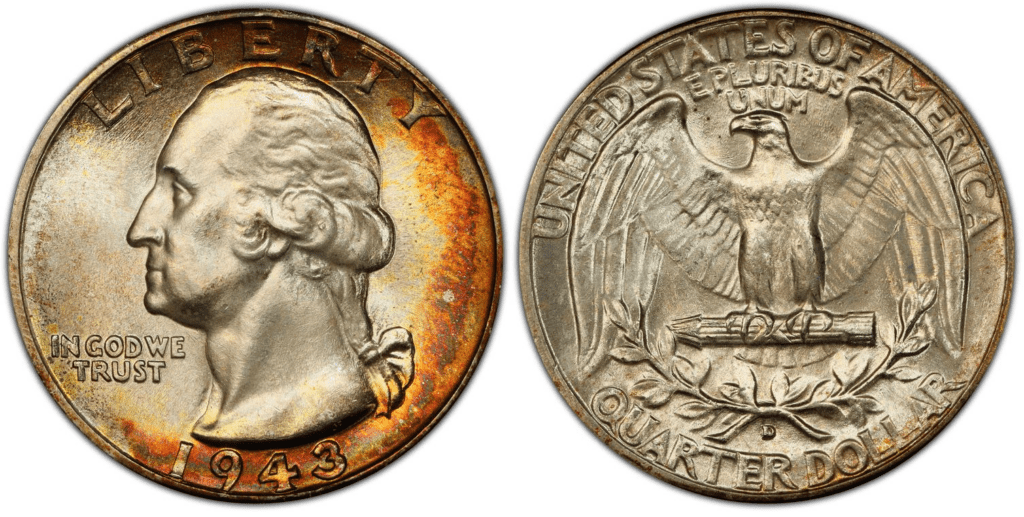
The Denver Mint produced the lowest number of the silver quarter in 1943, amounting to about 16 million. There are plenty of 1943-D quarters in circulated conditions up to a grade of MS 66 and MS 67. The selling price of this coin starts at around $8 to $25.
1943 P Washington Quarter
Edge: Reeded
Mint Mark: No mint mark
Place of minting: Philadelphia
Year of minting: 1943
Face Value: $0.25 (twenty-five cent)
Price: $4.95 to $7.50 (circulated condition)
Quantity produced: 99,700,000
Designer: John Flanagan
Composition: 90% silver and 10% copper
Mass: 6.30 grams
Diameter: 24.3 millimeters
Thickness: 1.75 millimeters
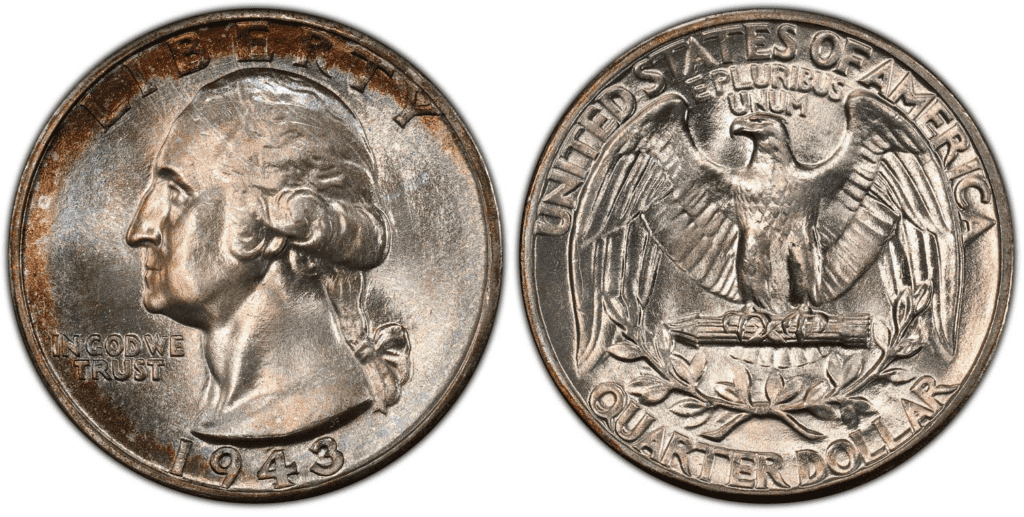
The Philadelphia Mint produced the most 1943 quarters with almost 100 million coins. Coins are common up to MS 66 grade. There are also plenty of MS67-graded 1943-P quarters. The price would usually hover around $4.95 to $7.50.
1943 S Washington Quarter
Edge: Reeded
Mint Mark: S
Place of minting: San Francisco
Year of minting: 1943
Face Value: $0.25 (twenty-five cent)
Price: $8 to $22.50 (circulated condition)
Quantity produced: 21,700,000
Designer: John Flanagan
Composition: 90% silver and 10% copper
Mass: 6.30 grams
Diameter: 24.3 millimeters
Thickness: 1.75 millimeters
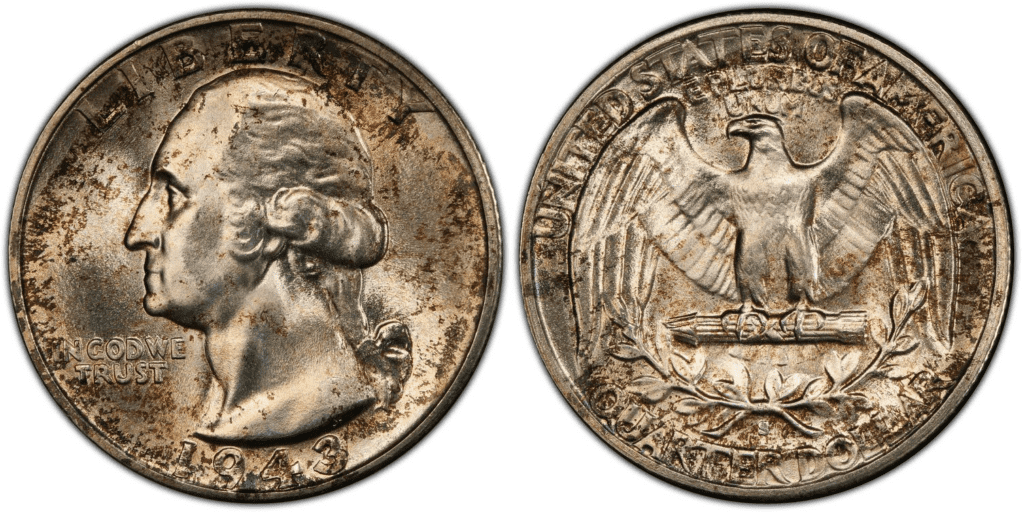
For some reason, the 1943-S quarter is generally more expensive than its coin brothers struck in the same year. The price can easily go up to $22.50. At the end of 1943, more than 21 million quarters were struck in the San Francisco Mint. You can easily know that a quarter is from San Francisco by identifying the S mintmark on the reverse side of the coin.
What’s interesting about the 1943 silver quarters is that a few were produced with a semi-proof-like appearance. This happened because the San Francisco Mint needed to repolish their worn dies more often. So, when the freshly polished die struck the planchet, they looked like proof coins.
List of 1943 Washington Quarter Errors
There were more than 137 million 1943 Washing quarters produced. With a massive amount of mintage figures, there was a higher chance of error coins appearing.
The most common 1943 Washington quarter error would be the doubled die obverse (DDO) error. This happened when the die struck the planchet twice. While the first and second strikes completely overlap, there are times when the doubling of the engraved elements would look obvious.
Here’s what a 1943 Washington quarter with a DDO error looks like:

There were also known 25-cent RPM errors or repunched mintmarks. This happens when the mintmark dies and hits the planchet twice.
Here’s what a repunched mintmark might look like:
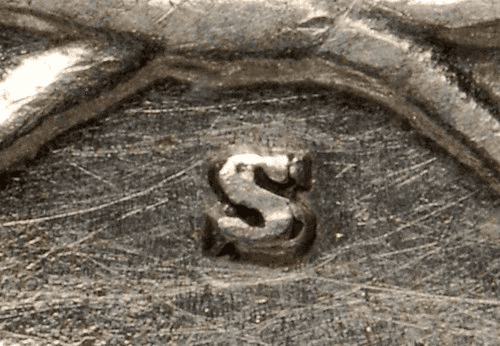
The image above would also be similar to the S over S error.
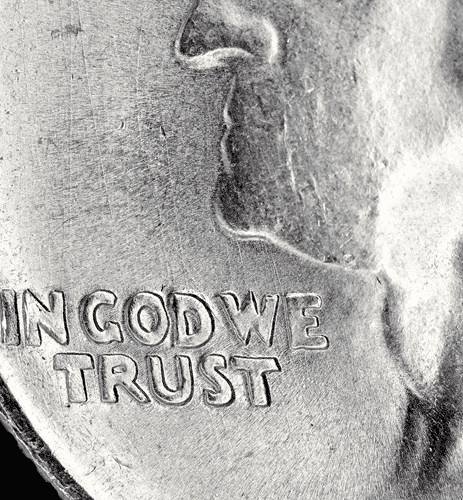
The error above makes Washington’s Adam’s apple look like it bulges more than it should.
There’s also the 1943 S “Trumpet S” error where the tail of the mintmark S looks like a trumpet:
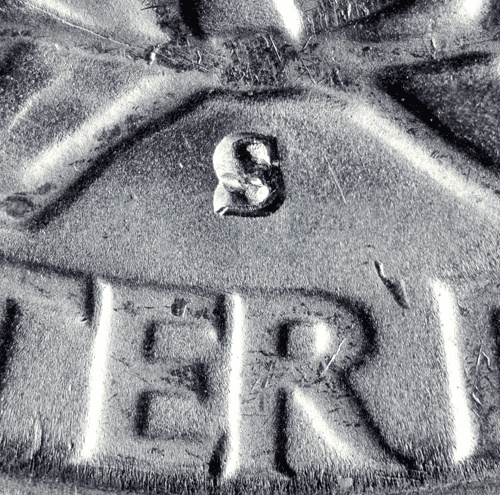
How Much Is The 1943 Washington Silver Quarter Worth Today?
The 1943 Washington silver quarter has a face value of 25 cents. Its melt value is $4.4525, which is higher considering that the coin was silver.
You might think that the 1943 Washington silver quarter is cheap and worthless. However, you shouldn’t just look at its face value or melt value. This coin can be worth more than that due to its age and rarity.
To give you an idea of its selling price, here’s a 1943 Washington Silver Quarter values chart:
| Coin | Condition | Grade | Mintage | Value |
| 1943 D Washington Quarter | Good | G-4 to G-6 | 16,095,600 | $6.26 |
| 1943 D Washington Quarter | Fine | F-12 to F-15 | 16,095,600 | $6.26 |
| 1943 D Washington Quarter | Extremely Fine | XF-40 to XF-45 | 16,095,600 | $7.44 |
| 1943 D Washington Quarter | Uncirculated | MS-60 to MS-62 | 16,095,600 | $33
|
| 1943 D Washington Quarter | Gem Uncirculated | MS-65 to MS-66 | 16,095,600 | $27 to $104 |
| 1943 D Washington Quarter | Superb Gem Uncirculated | MS-67 to MS-68 | 16,095,600 | $180 to $17,625 |
| 1943 P Washington Quarter | Good | G-4 to VF-35 | 99,700,000 | $6.26 |
| 1943 P Washington Quarter | Extremely Fine | XF-40 to XF-45 | 99,700,000 | $6.87 |
| 1943 P Washington Quarter | About Uncirculated | AU-50 to AU-58 | 99,700,000 | $7.44 |
| 1943 P Washington Quarter | Uncirculated | MS-60 to MS-62 | 99,700,000 | $8.39 |
| 1943 P Washington Quarter | Gem Uncirculated | MS-65 to MS-66 | 99,700,000 | $22 to $80 |
| 1943 P Washington Quarter | Superb Gem Uncirculated | MS-67 to MS-68 | 99,700,000 | $144 to $11,163 |
| 1943 S Washington Quarter | Good | G-4 to VF-35 | 21,700,000 | $6.26
|
| 1943 S Washington Quarter | Extremely Fine | XF-40 to XF-45 | 21,700,000 | $8.39
|
| 1943 S Washington Quarter | About Uncirculated | AU-50 to AU-58 | 21,700,000 | $13 |
| 1943 S Washington Quarter | Uncirculated | MS-60 to MS-62 | 21,700,000 | $8.38 |
| 1943 S Washington Quarter | Gem Uncirculated | MS-65 to MS-66 | 21,700,000 | $28 to $264 |
| 1943 S Washington Quarter | Superb Gem Uncirculated | MS-67 to MS-68 | 21,700,000 | $336 to $23,000 |
As you can see, some 1943 silver quarter coins are just too valuable. You should be able to fully appreciate its value by looking at the auction records for each variety:
- $23,000 – a 1943 25C (Regular Strike) coin with a grade of MS68 sold in April 2012 by Heritage Auctions
- $23,000 – a 1943-S 25C (Regular Strike) coin with a grade of MS68 sold in April 2008 by Bowers & Merena
- $17,625 – a 1943-D 25C (Regular Strike) coin with a grade of MS68 sold in January 2013 by Heritage Auctions
How Does The Grading System Work?
The Sheldon Scale is used by numismatists to provide a numerical value to coins. The Sheldon Scale goes from poor (P-1) to perfect mint state (P-1) (MS-70). Coins were originally evaluated using words to reflect their condition (Good, Fair, Excellent, Etc.). Unfortunately, coin collectors and dealers had different ideas about what each of these terms represent.
Professional numismatists joined together in the 1970s and established CoinGrading standards. These numismatists now assign grades at key places on the seventy-point scale, using the most regularly utilized numeric points in conjunction with the original adjective grade. The following are the most common coin grades:
-
-
- (P-1) Poor – Indistinguishable and probably damaged; if used, must have a date and mintmark; otherwise, rather battered.
- (FR-2) Fair – Nearly smooth, but without the damage that a coin graded Poor often possesses. The coin must have enough detail to be identified.
- (G-4) Fair – Inscriptions have merged into the rims in some areas, and important elements have been mostly erased.
- (VG-8) Very Good- A little weathered, but all of the primary design elements are visible, albeit faintly. There is little if any, central detail left.
- (F-12) Good – The item is very worn, yet the wear is even, and the overall design details stand out clearly. Rims are almost completely isolated from the field.
- (VF-20) Very Fine – Moderately weathered, with some finer features still visible. The motto or all letters of LIBERTY are readable. Both sides of the coin have entire rims that are separated from the field.
- (EF-40) Extremely Fine – Gently used; all gadgets are visible, and the most important ones are bold. The finer details are bold and clear, however, light wear may be seen.
- (AU-50) Uncirculated – Slight evidence of wear on the coin’s design’s high points; may have contact marks; eye appeal should be adequate.
- (AU-58) Uncirculated Choice – Slight traces of wear, no severe contact marks, almost full mint shine, and great eye appeal.
- (MS-60) Mint State Basal – Strictly uncirculated; no indication of wear on the coin’s highest points, but an unsightly coin with reduced luster, visible contact marks, hairlines, and other flaws.
- (MS-63) Mint State Acceptable – Uncirculated, but with contact scratches and nicks, little reduced shine, but otherwise appealing appearance. The strike is weak to average.
- (MS-65) Mint State Choice – Uncirculated with great mint shine, very little contact blemishes, and exceptional eye appeal. The strike is unusually severe.
- (MS-68) Mint State Premium Quality – Uncirculated with superb luster, no obvious contact marks to the naked eye, and exceptional eye appeal. The strike is quick and appealing.
- (MS-69) Almost Perfect Mint State – Uncirculated with perfect brilliance, a sharp and appealing strike, and extremely good eye appeal. A near-perfect coin with minor imperfections in the planchet, strike, and contact markings (seen only under 8x magnification).
- (MS-70) Mint State Perfect – Under 8x magnification, there are no tiny imperfections discernible; the strike is crisp, and the coin is perfectly centered on a beautiful planchet. Rarely seen on a coin, this coin is bright and whole, with original luster and exceptional eye appeal.
-
Where To Buy Or Sell 1943 Washington Silver Quarter?
The 1943 Washington silver quarter is available online and offline. You can directly visit eBay and Amazon. These websites have a lot of old coins for sale in their inventory. You can also do a Google search. You’ll instantly find websites that specialize in selling and buying coins.
Aside from the Internet, you can go to coin shops or antique stores. You can also try pawn shops. Auction houses also offer some of the rarest coins available today.
FAQs
Is a 1943 quarter pure silver?
No, the 1943 quarter isn’t purely silver. While it is made of 90% silver, it is also made of 10% copper.
How much is a 1943 solid silver quarter worth?
A 1943 solid silver quarter has a melt value of around $4. However, try the open market if you want to sell it for a higher price. One 1943 silver quarter was even sold for about $23,000.
Is there anything special about the 1943 quarter?
The 1943 quarter is special because it’s an old coin. Aside from that, it is made of silver. The coin was even made during World War II, which increased its sentimental value.
